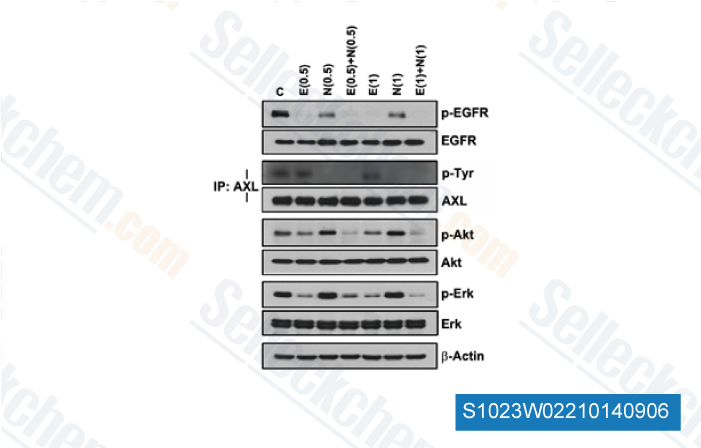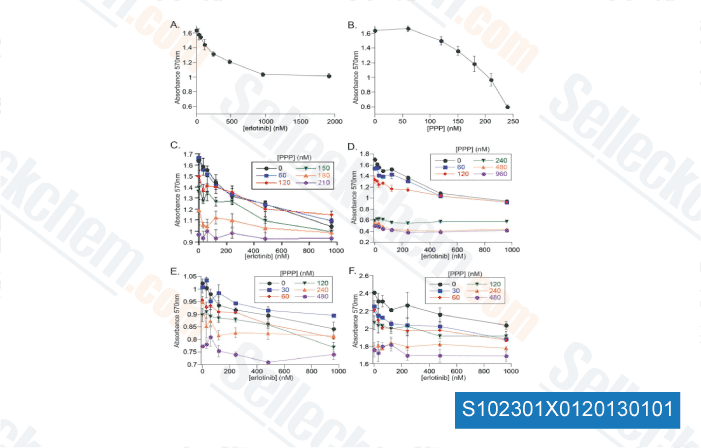|
Toll Free: (877) 796-6397 -- USA and Canada only -- |
Fax: +1-832-582-8590 Orders: +1-832-582-8158 |
Tech Support: +1-832-582-8158 Ext:3 Please provide your Order Number in the email. |
Technical Data
| Formula | C22H23N3O4 |
|||
| Molecular Weight | 393.44 | CAS No. | 183321-74-6 | |
| Solubility (25°C)* | In vitro | DMSO | 78 mg/mL (198.25 mM) | |
| Ethanol | 21 mg/mL (53.37 mM) | |||
| Water | Insoluble | |||
|
* <1 mg/ml means slightly soluble or insoluble. * Please note that Selleck tests the solubility of all compounds in-house, and the actual solubility may differ slightly from published values. This is normal and is due to slight batch-to-batch variations. * Room temperature shipping (Stability testing shows this product can be shipped without any cooling measures.) |
||||
Preparing Stock Solutions
Biological Activity
| Description | Erlotinib is an EGFR inhibitor with IC50 of 2 nM, >1000-fold more sensitive for EGFR than human c-Src or v-Abl. Erlotinib induces autophagy. | ||
|---|---|---|---|
| Targets |
|
||
| In vitro | Erlotinib HCl potently inhibits EGFR activation in intact cells including HNS human head and neck tumor cells (IC50 20nM), DiFi human colon cancer cells and MDA MB-468 human breast cancer cells. Erlotinib HCl (1 μM) induces apoptosis in DiFi human colon cancer cells. [1] Erlotinib inhibits growth of a panel of NSCLC cell lines including A549, H322, H3255, H358 H661, H1650, H1975, H1299, H596 with IC50 ranging from 29 nM to >20 μM. [2] Erlotinib HCl(2 μM) significantly inhibits growth of AsPC-1 and BxPC-3 pancreatic cells. [3] The effects of Erlotinib HCl in combination with gemcitabine are considered additive in KRAS-mutated pancreatic cancer cells. Ten micromolar of Erlotinib HCl inhibits EGFR phospho-rylation at the Y845 (Src-dependent phosphorylation) and Y1068 (auto-phosphorylation) sites. [4] Combination with Erlotinib HCl could down-modulate rapamycin-stimulated Akt activity and produces a synergistic effect on cell growth inhibition. [5] |
||
| In vivo | At doses of 100 mg/kg, Erlotinib HCl completely prevents EGF-induced autophosphorylation of EGFR in human HN5 tumors growing as xenografts in athymic mice and of the hepatic EGFR of the treated mice. [1] Erlotinib HCl (100 mg/Kg) inhibits H460a and A549 tumor models with 71 and 93% inhibition rate. [5] |
Protocol (from reference)
| Kinase Assay: |
|
|---|---|
| Cell Assay: |
|
| Animal Study: |
|
References
Customer Product Validation

-
Data from [Cancer Res, 2014, 4(1):253-62]

-
Data from [Head Neck, 2013, 35, 86-93]

-
Data from [Tuberc Respir Dis, 2013, 75(1), 9-17]

-
Data from [Nat Genet, 2012, 44(8):852-60]
Selleck's Erlotinib has been cited by 606 publications
| TWIST1 is a critical downstream target of the HGF/MET pathway and is required for MET driven acquired resistance in oncogene driven lung cancer [ Oncogene, 2024, 10.1038/s41388-024-02987-5] | PubMed: 38485737 |
| A destabilizing Y891D mutation in activated EGFR impairs sensitivity to kinase inhibition [ NPJ Precis Oncol, 2024, 8(1):3] | PubMed: 38182677 |
| Non-small cell lung cancer cells with uncommon EGFR exon 19delins variants respond poorly to third-generation EGFR inhibitors [ Transl Oncol, 2024, 39:101834] | PubMed: 38006760 |
| Extracellular domain mutations of the EGF receptor differentially modulate high affinity and low affinity responses to EGF receptor ligands [ J Biol Chem, 2024, S0021-9258(24)00139-X] | PubMed: 38367671 |
| Secondary Mutations of the EGFR Gene That Confer Resistance to Mobocertinib in EGFR Exon 20 Insertion [ J Thorac Oncol, 2023, S1556-0864(23)00797-9] | PubMed: 37666482 |
| Cellular mechanisms of heterogeneity in NF2-mutant schwannoma [ Nat Commun, 2023, 14(1):1559] | PubMed: 36944680 |
| SPINK1-induced tumor plasticity provides a therapeutic window for chemotherapy in hepatocellular carcinoma [ Nat Commun, 2023, 14(1):7863] | PubMed: 38030644 |
| Targeting GSTP1 as Therapeutic Strategy against Lung Adenocarcinoma Stemness and Resistance to Tyrosine Kinase Inhibitors [ Adv Sci (Weinh), 2023, 10(7):e2205262] | PubMed: 36709476 |
| "Proteotranscriptomic analysis of advanced colorectal cancer patient derived organoids for drug sensitivity prediction" [ J Exp Clin Cancer Res, 2023, 42(1):8] | PubMed: 36604765 |
| Exploring circular MET RNA as a potential biomarker in tumors exhibiting high MET activity [ J Exp Clin Cancer Res, 2023, 42(1):120] | PubMed: 37170152 |
RETURN POLICY
Selleck Chemical’s Unconditional Return Policy ensures a smooth online shopping experience for our customers. If you are in any way unsatisfied with your purchase, you may return any item(s) within 7 days of receiving it. In the event of product quality issues, either protocol related or product related problems, you may return any item(s) within 365 days from the original purchase date. Please follow the instructions below when returning products.
SHIPPING AND STORAGE
Selleck products are transported at room temperature. If you receive the product at room temperature, please rest assured, the Selleck Quality Inspection Department has conducted experiments to verify that the normal temperature placement of one month will not affect the biological activity of powder products. After collecting, please store the product according to the requirements described in the datasheet. Most Selleck products are stable under the recommended conditions.
NOT FOR HUMAN, VETERINARY DIAGNOSTIC OR THERAPEUTIC USE.
